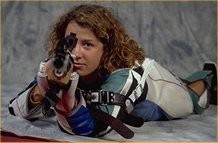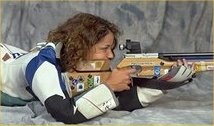International rules require a minimum angle of 30 degrees between the ground and the forearm. A low forearm angle will produce higher sling tension. A shallow angle between the forearm and sling, which comes from the sling being attached low on the upper arm, also results in higher sling tension. I recommend trying to get a very tight position with very firm contact between the shoulder and the buttplate. I like to get around behind the rifle so that I relax directly toward the target. With my weight pushing toward the target, the sling is exerting the balancing force back away from the target.
This position has the added benefits of reduced recoil, easier loading and a more consistent position. Recoil is reduced by the tight position and by having more of your weight behind the rifle. If you are behind the rifle, shooting out of your position rather than across it, you can also shoot with a shorter stock. This makes it easier to load and less likely that you will disturb your position in the process.
Question: How do I adjust the sling length to support the rifle in those positions?
Answer: Start with a position based on the principles mentioned above. Attach the sling to your arm so that it canít slide down during the course of fire. In prone, adjust the sling length so that the forearm makes an angle of 30 to 45 degrees with the ground. In competition, below 30 degrees is illegal, and I donít know of any good shooters using an angle over 45 degreesóitís very hard to get stable if you are up that high. I find that about 35 degrees is ideal for stability without worrying about a match official constantly checking for the minimum. In kneeling, I like to adjust the sling so that the forearm continues a straight line formed by the thigh. This is a stable position and allows the recoil to be transmitted along that straight line rather than trying to change an angle that you want to keep constant.
For both positions try attaching the sling high up on the arm to reduce sling tension. Even sporter rifle rules in three-position air rifle allow a button or pin to keep the sling in place. USE IT! Always remember to twist the sling a half turn so that it rides smoothly across the inside of your wrist and the back of your hand. A glove is required for comfort. |


